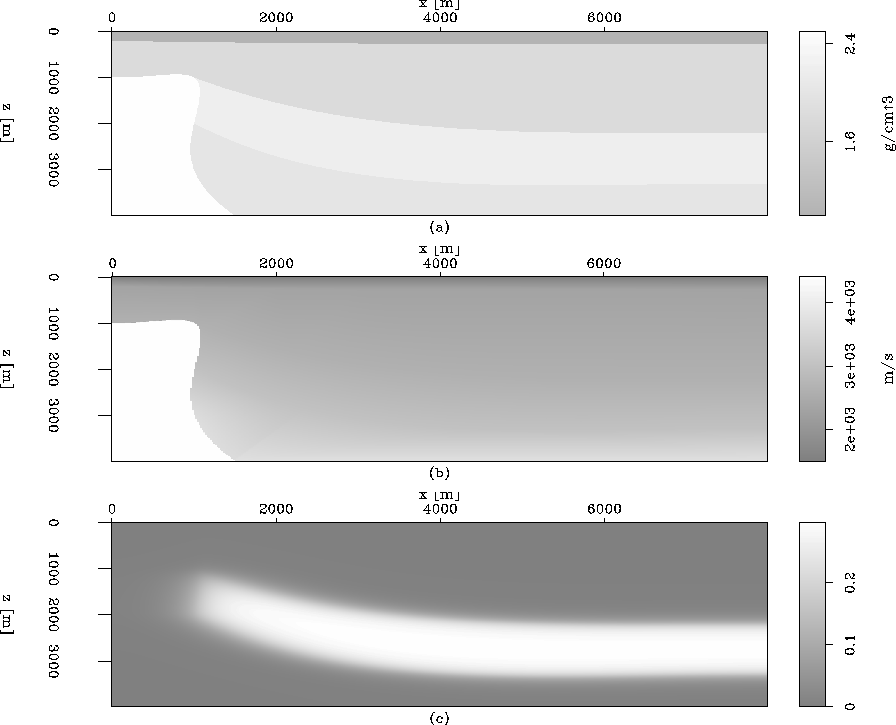




Next: Numerical example
Up: Shan and Biondi: Steeply
Previous: VTI media in tilted
In plane-wave migration Duquet et al. (2001); Liu et al. (2002); Rietveld (1995); Zhang et al. (2003) source wavefields are decomposed into plane waves,
and the receiver wavefields are re-arranged corresponding to their respective plane-wave source.
Shan and Biondi (2004a) apply plane-wave migration in tilted coordinates for an isotropic medium.
For each plane wave, proper tilted coordinates are designed, whose tilting angle is selected according to the
direction in which the plane wave propagates.
Source and receiver wavefields are downward continued in these tilted coordinates. Images and dip-dependent
angle-domain common-image gathers (CIGs) are generated by cross-correlation.
Anisotropic plane-wave migration is the same as isotropic plane-wave migration,
except that an anisotropic correction operator is applied after the isotropic wavefield
extrapolation at each depth step. Since the correction operator is explicit,
we build a table of convolution coefficients before we run the wavefield extrapolation.
If the medium at a point in space is isotropic ( ), only the isotropic extrapolation will occur.
Otherwise, the anisotropic correction operator will be applied to the wavefield.
For anisotropic correction, we search for the filter coefficients corresponding to the tilting angle
), only the isotropic extrapolation will occur.
Otherwise, the anisotropic correction operator will be applied to the wavefield.
For anisotropic correction, we search for the filter coefficients corresponding to the tilting angle  ,
anisotropy parameters
,
anisotropy parameters  and
and  and the value of
and the value of  in the table and convolve
the wavefield at that spatial position with these coefficients. As in the isotropic case,
images and dip-dependent angle-domain CIGs can be created by cross-correlating the source and receiver wavefields.
in the table and convolve
the wavefield at that spatial position with these coefficients. As in the isotropic case,
images and dip-dependent angle-domain CIGs can be created by cross-correlating the source and receiver wavefields.
model
Figure 2 Model of the synthetic dataset.
(a) Density model; (b) Velocity model; (c) Anisotropy parameter  .
.




 nearoffset
nearoffset
Figure 3 A near-offset section of the synthetic data.










Next: Numerical example
Up: Shan and Biondi: Steeply
Previous: VTI media in tilted
Stanford Exploration Project
5/3/2005
![]() ), only the isotropic extrapolation will occur.
Otherwise, the anisotropic correction operator will be applied to the wavefield.
For anisotropic correction, we search for the filter coefficients corresponding to the tilting angle
), only the isotropic extrapolation will occur.
Otherwise, the anisotropic correction operator will be applied to the wavefield.
For anisotropic correction, we search for the filter coefficients corresponding to the tilting angle ![]() ,
anisotropy parameters
,
anisotropy parameters ![]() and
and ![]() and the value of
and the value of ![]() in the table and convolve
the wavefield at that spatial position with these coefficients. As in the isotropic case,
images and dip-dependent angle-domain CIGs can be created by cross-correlating the source and receiver wavefields.
in the table and convolve
the wavefield at that spatial position with these coefficients. As in the isotropic case,
images and dip-dependent angle-domain CIGs can be created by cross-correlating the source and receiver wavefields.

